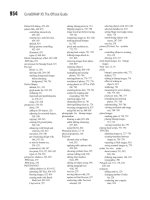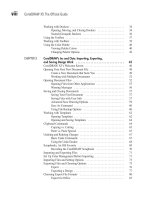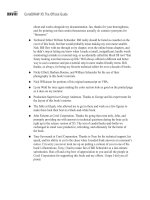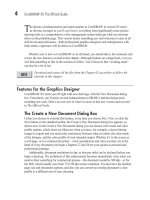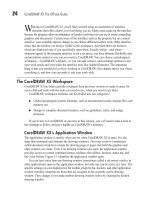CorelDRAW X5 The Official Guide part 18 pot
Bạn đang xem bản rút gọn của tài liệu. Xem và tải ngay bản đầy đủ của tài liệu tại đây (384.83 KB, 10 trang )
6. By default, the envelope is in Putty mode, which presents both an advantage and a
disadvantage. The advantage is that in Putty mode, you can delete envelope nodes;
the disadvantage is that all the segments that join the nodes are curves, and you want
straight envelope segments for this text. No problem: with the cursor, marquee-select
the 3 and the 9 o’clock nodes. Then either click to remove them by clicking the
Delete Nodes button on the property bar, or press – (minus) on the keyboard keypad.
7. Marquee-select all the remaining nodes, and then click the Convert To Line icon on the
property bar. Then click inside the envelope to deselect the nodes. See Figure 5-7.
8. Click the top center envelope node, and then hold CTRL (to constrain movement to
the first direction in which you drag) and drag upwards to make a peak in the center
of the text.
9. Click the bottom center envelope node, hold CTRL, and then drag down until the
bottom of the text overlaps the gears just a little, as shown in Figure 5-8.
You can also nudge envelope nodes by selecting one or more of them, and then
pressing the keyboard arrow keys. This technique can provide precise editing of the
envelope shape.
134 CorelDRAW X5 The Official Guide
FIGURE 5-7 Make an envelope with custom properties from the default envelope.
Select and then remove middle side Envelope nodes.
Convert To Lines
Applying the Conical Fountain Fill
Fountain fills, when used appropriately, can give a feeling of motion to static objects, and
occasionally can soften the look of large objects without stealing from their visual importance.
The DYSON GEARS is a tad overpowering as is, so a Conical fountain fill type will serve
two purposes: to play down its massive presence just a little, and to make the text look a
little metallic. Also, the headline should go behind the gears design; it will still be legible,
and the slight overlap helps visually integrate the two groups of shapes.
Follow these steps to finish the headline work.
Applying a Custom Fountain Fill
1. Select the enveloped text with the Pick tool, and then press SHIFT+PAGE DOWN to
send it to the back of the illustration. Vector objects have a page order; the last-
created object is drawn on the top of the stack.
2. Choose the Interactive Fill tool from the toolbox.
3. Choose Conical from the Fill Type drop-down list on the property bar. The text
changes color and the color wells for the Conical fill type appear above the text.
4. Drag the white color handle to 6 o’clock relative to the text to set the To position for
the fill, and then with the color handle selected, click the 10% black color well on
the Color Palette. Cool, eh? See Figure 5-9.
CHAPTER 5: The X5 Test Drive 135
5
FIGURE 5-8 Create a dynamic headline for the T-shirt design by suggesting that the
perspective of the text is coming at the audience from the center.
Adding and Aligning Text
Congratulations! The hard work is behind you now—and it wasn’t really all that hard now,
was it? Next stop is adding the URL for Dyson Gears, performing a little alignment work,
and then on to setting up the design for printing.
Adding a Visually Compatible Subhead
1. VAG Rounded is a beautiful, fairly serious typeface, and an ideal complement to the
no-nonsense design of this logo. It’s on the CorelDRAW Fonts installation CD, and
its filename is tt0756m_.ttf. Install it now if you want to use it in the following steps.
2. With the Text tool, click an insertion point to the left and below the gears. Type
www.dysongears.com.
3. Choose the Pick tool, and then with the text selected, choose VAG Rounded BT
from the Font list, insert your cursor into the Point Size field, and then type 36. Half
an inch is a good size for the design when printed to a T-shirt.
136 CorelDRAW X5 The Official Guide
FIGURE 5-9 Add some flair to the text while also reducing its visual importance with a
fountain fill.
4. Marquee-select the envelope headline text and the gears. Press CTRL+G to group
these two groups of objects.
5. Press CTRL+A to select all.
6. Choose Arrange | Align and Distribute | Align and Distribute to make it easiest to
see and execute the controls for aligning objects.
7. Click the Center check box, as shown in Figure 5-10, and then click Apply. You can
close the Align And Distribute box now. If you needed to do some heavy-duty,
multiple aligning work in a design, you’d keep this box open and convenient for
future use.
Align, Group, Scale, Flip, and Print
You’re already familiar with most of the techniques covered in the upcoming tutorial that
shows how to do one or two minor things to the finished logo to make it printworthy. Yes,
you’re coming in to home base and concluding the X5 Test Drive, but let’s make this
assignment a top-to-bottom, complete excursion. Follow these steps to brush up the logo
design a little, and to set it up for output to an inkjet printer.
CHAPTER 5: The X5 Test Drive 137
5
FIGURE 5-10 Use Align And Distribute to perfectly center multiple design elements.
Getting Your Logo Design into the Real World
1. Select all (CTRL+A) and then press CTRL+G to group all the selected shapes.
2. Let’s get your money’s worth out of the print by making the logo that 7 inches
maximum that was agreed upon at the beginning of the chapter (okay, you might not
have actually agreed, but play along here). With the group selected, type 7 in the
horizontal width field on the property bar, make sure the Lock Ratio (little lock) icon
is depressed, and then press
ENTER. Then press P to center the design relative to the
page.
3. T-shirt transfers need to be printed as the reverse of the imprint; that is, the text
needs to be mirrored so that when the inkjet page is ironed onto the shirt, it reverses
back again to legibility. Click the Mirror Horizontally button on the property bar,
which is easy enough to undo later if your logo is needed for a promotion other than
T-shirts. See the illustration next.
Ill 5-13
4. Put a piece of regular paper in the inkjet printer, and print a copy of the design.
Press
CTRL+P, choose the correct printer, and then click Print. This is a “proof of
concept” print; T-shirt transfers cost about a dollar each, while plain paper costs
significantly less, cheaper still if you print on the backside of a page that has already
been printed with something expendable. If everything seems to be satisfactory with
the test print, do it for real with the T-shirt transfer paper.
138 CorelDRAW X5 The Official Guide
With the exception of that all-night pizzeria around the corner, all good things must
come to an end. You’ve passed the test drive. You’re home safe and didn’t dent a fender, and
the best part is, you get to pocket the keys. You’re going to need them when you take this
high-performance Model X5 out on your own and take the bends and curves in the chapters
to come!
The Test Drive Cross-Reference
You haven’t really broken in all the features and tools covered in this chapter, so here are the
signposts to learn more about the editing and transforming you performed in this chapter:
●
Aligning and Distributing Objects: Chapter 9
●
Extruding Objects: Chapter 19
●
Guidelines and Rulers: Chapter 7
●
The Envelope Tool: Chapter 20
●
Working with Text: Chapters 12 and 13
●
Filling Objects: Chapter 15
See Chapter 3 for the basics on the Color Palette, and for saving and opening documents.
But you probably already know that stuff.
CHAPTER 5: The X5 Test Drive 139
5
This page intentionally left blank
PART II
Getting Started with
CorelDRAW X5
This page intentionally left blank
CHAPTER 6
Working with Single-
and Multi-Page
Documents
143
